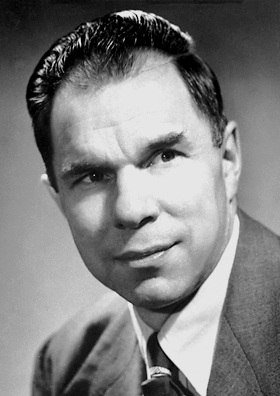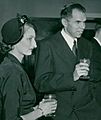Glenn Seaborg facts for kids
Glenn Theodore Seaborg (born April 19, 1912 – died February 25, 1999) was a very important American chemist. He was born in Ishpening, Michigan. He is famous for discovering many new chemical elements.
In 1951, he won the Nobel Prize in Chemistry. He shared this award with Edwin M. McMillan. They were recognized for their discoveries of new elements heavier than uranium.
Seaborg also worked on the Manhattan Project during World War II. This was a secret project to develop the first atomic bomb. He studied the chemical properties of plutonium for this important research.
Later, he led the Atomic Energy Commission. He was also a professor at the University of California, Berkeley.
Contents
Discovering New Elements
Glenn Seaborg was a key scientist in finding ten new elements. These elements are:
- Plutonium
- Americium
- Curium
- Berkelium
- Californium
- Einsteinium
- Fermium
- Mendelevium
- Nobelium
- Element 106, which was named seaborgium in his honor. This was special because it was named after him while he was still alive!
He also created over 100 different isotopes of atoms. Isotopes are versions of an element with a different number of neutrons.
Pioneering Nuclear Medicine
Early in his career, Seaborg helped start the field of nuclear medicine. He created many isotopes that helped doctors find and treat diseases. For example, he studied iodine-131. This isotope is still used today to treat problems with the thyroid gland.
Understanding the Periodic Table
Seaborg made a big change to how we understand the periodic table. He came up with the "actinide concept." This idea placed the actinide series of elements below the lanthanide series on the table. This made the periodic table more organized and easier to understand. He also suggested where even heavier, "super-heavy" elements might fit.
Turning Bismuth into Gold
In 1980, Glenn Seaborg did something amazing. He changed a small amount of bismuth into gold. He did this at the Lawrence Berkeley National Laboratory. He used a special method from nuclear physics. This method removed protons and neutrons from the bismuth atoms.
While his method worked, it would have cost too much money to make a lot of gold this way. Still, his work was the closest anyone has come to the old myth of the Philosopher's Stone. This mythical stone was said to turn other metals into gold.
Images for kids
-
Seaborg in 1950, with the ion exchanger elution column of actinide elements.
-
Seaborg (second from left) during Operation Plumbbob
-
From left to right: Chairman Seaborg, President Kennedy, Secretary McNamara on March 23, 1962. By this point, McNamara and Seaborg had been discussing the AEC's studies on the ecological effects of nuclear war and "clean" weapon alternatives. (Courtesy: National Security Archive, Original: National Archives)
-
Seaborg (right) with marine biologist Dixy Lee Ray on September 17, 1968
See also
 In Spanish: Glenn T. Seaborg para niños
In Spanish: Glenn T. Seaborg para niños








